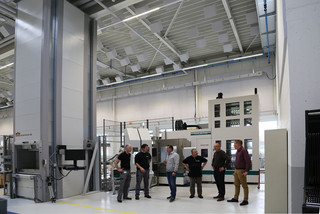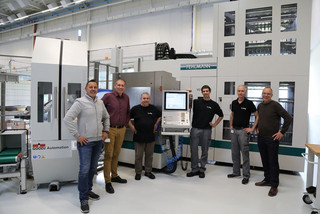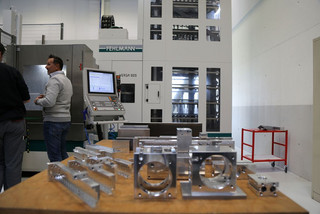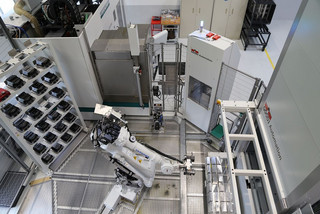Goodj-Fehlmann: "chaotic" round-the-clock production
In Afag Automation AG's new company building, one of the most modern, highly flexible production islands, based on a Goodj automation system with a fully integrated Fehlmann VERSA 825, is being built. In the future, up to 250 aluminum components will be produced autonomously and "chaotically" on this system, parts handling included. In short, it is a showcase project of how production can be carried out economically in Switzerland.
The new Afag headquarters offers 120 employees, in the areas of research, design and development through to production and assembly, excellent structural conditions for developing and producing Swiss-made automation components. Afag has high-end competencies in the fields of supplying, handling, transporting and engineering. At the location in Zell, supplying as well as production and assembly of the automation components are being realized.
Lighthouse project 1: Afag headquarters
On October 11, 2021, the new Afag corporate headquarters in Zell was officially inaugurated. Afag owner Alexander Schaeff described the new building as a lighthouse project. He said the new building was ideally tailored to the needs of the production and assembly operation.
Lighthouse project 2: modern production island
The second lighthouse project is the newly integrated production island, which was developed by Goodj and Fehlmann to manufacture 250 different basic bodies for Afag handling technology in the future, unmanned and autonomously. Typical batch sizes are 6 to 48 pieces. The manufacturing island is not only for the in-house production of components, but also to enable a just-in-time supply chain, allowing the reduction of inventory levels.
Integral components of the manufacturing island are:
- Fehlmann VERSA 825 with 346 tool storage system
- Goodj: control, automation and clamping systems
- High rack raw material and finished parts warehouse
- Yaskawa articulated arm robot for parts handling
- Chip pressing and disposal system
- MDM tool management and pre-setting system
- Quality assurance, measurement technology
Goodj PLC control sets the pace
The entire production island is controlled by a PLC control system from Goodj.
Hansruedi Good (CEO, Goodj Automation AG): "We developed the control system, which is based on an object-oriented software concept, in-house, and our customers benefit considerably from this. For example, we don't actually use the PLC from the robot - the robot is controlled directly via our software/controller. The added value for the customer: he does not have to deal with the robot control. Our control system supports all common industrial protocols, so any components can be integrated. This openness of the controlled systems is a decisive factor. Whether high rack, robot, VERSA 825 machine tool or chip press - these are all peripheral devices for us. We have to program interfaces for these peripheral devices. The programmed interfaces are central to cell management and the basis for a manufacturing island that runs smoothly."
Precision and complexity of components:
As part of the evaluation, a complex set of specifications was drawn up, based on the enormous range of components. The only thing all components have in common is the material: aluminum.
- System must be able to manufacture 250 cubic components fully automatically
- 6-sided complete machining, including de-burring by machine
- Fully automatic provisioning of raw parts, as well as fully automatic clamping and re-clamping of components within production island
- Up to 72 hours of unmanned and chaotic production
- Over 7000 hours of run-time per year (1 year = 8760h)
To make matters more challenging, the form and position tolerances of specific guide bores are IT6, which means they have very tight tolerances. The IT6 tolerances are necessary so that the parallel guide rods with plain bearings can be moved axially with absolute ease and process reliability. Right from the start, it was clear that the guide bores had to be manufactured using the reversal method. In this case, a high-precision machine that is capable of ensuring this tolerance class in reversal-method production – with high process reliability for serial manufacturing - was required. The required precision was an exclusion criterion for some machine tool manufacturers and one of the main reasons why the Fehlmann VERSA 825 was ultimately chosen.
Due to the complexity of the production island, the Afag specialists demanded a responsible contact partner as general contractor for the entire system, both during the planning phase and for the subsequent service and maintenance.
A current update - 50 different components are running on the production island right now. The CAD/CAM developers have already programmed 80 components. The goal is to run 250 components on the system. Currently, 18 different blanks are provided for the 50 components.
Production thus far
Some of the components have already been manufactured in-house on a 4-axis horizontal machining center. Rolf Zaugg (Team Leader Manufacturing, Afag): "The machine had a pallet station with clamping towers, where the components had to be clamped by hand and re-clamped manually for machining on the back side. Subsequently, the components were de-burred manually. Compared to the current production island, this type of production is no longer up to date; it is less process-reliable, inflexible, labor-intensive and ultimately cost-intensive because of the manual interventions."
The evaluation phase
Andreas Gartenmann (Plant Manager, Afag): "At the beginning of the evaluation phase, we approached several machine tool manufacturers and described the challenges to them. This included Fehlmann AG, with whom we had a close technical exchange - with Jürg Solenthaler (Sales Manager Switzerland, Fehlmann AG)."
R. Zaugg: " Soon Goodj Automations AG was also recommended to us as a general contractor. Looking back, we can say that this was a bull's eye, because Goodj proved to be the perfect solution. Nevertheless, we started the evaluation phase in parallel with other machine tool manufacturers, for Fehlmann as well as Goodj."
A. Gartenmann: "Our biggest concern with this project was the interface problem, because of the different systems that had to be networked, with integrated controls and software systems. In the initial discussions with Goodj, it quickly became apparent that they had already implemented similar systems, and Hansruedi Good showed us what we needed to be aware of when it came to interface issues."
Andreas Gartenmann (Plant Manager, Afag): "At the beginning of the evaluation phase, Goodj put us in contact with the responsible production managers, with whom we discussed their solutions and viewed their machines on site. This was a very important and instructive process for us. Based on this experience, we made a preliminary plan and, in close coordination with Goodj, further developed the catalog of requirements. The result was a complex manufacturing matrix that formed the basis of the manufacturing island. In parallel, we solicited quotes from machine tool manufacturers."
It quickly became clear that Goodj was the ideal system partner for the requirements. Goodj recommended a flexible workpiece clamping solution, including a re-clamping station for machining the back side. The storage and provision of the workpieces (raw and finished parts) was implemented using a high-rack system. Handling within the production island is performed by an articulated-arm robot. The palletized clamping devices are from Goodj. Chip management was realized with a chip pressing system. When selecting the machine tool, the advantages of the Fehlmann VERSA 825 stood out relatively quickly.
Fehlmann VERSA 825 – the perfect machine tool
Hansruedi Good, Goodj Automation AG: "Machine tools are among the most complex systems in the production island. Accordingly, it is important to choose the right one. As a general contractor, we usually work with different manufacturers. The openness of their systems for our central control is crucial. And this is precisely where Fehlmann shows its strengths - through these ease with which it can integrate itself into such a system in terms of control technology. This is not always the case."
However, control compatibility is only one aspect of why the Afag specialists decided on the Fehlmann VERSA.
Fehlmann: first production trials
A. Gartenmann: "Because of the high precision requirements, we ran initial production trials with Fehlmann at the beginning of the evaluation phase. It was important to J. Solenthaler that we manufacture the components under real conditions, since IT6 form and position tolerances are anything but a matter of course in reversal-method series production. We noticed immediately that Fehlmann's manufacturing specialists had assessed the situation correctly and did not want to leave anything to chance."
R. Zaugg: "During the manufacturing trials, Fehlmann was able to confirm to us that they could meet the required precision on their standard machine under the given conditions. Another advantage of the Fehlmann VERSA 825 was the adaptation of the Goodj clamping devices directly into the machine. No adapter plates are required. This cannot be taken for granted. In addition, there was the ingenious machine design that allows the components to be fed from the side."
De-burring of the workpieces was also an important issue. Says Niklaus Joss (CNC programmer, Afag), "This is ultimately a key reason why a 5-axis simultaneous machining center is needed. Because without a 5th axis, machine de-burring is not feasible."
Thermal stability and compensation
Another essential factor for unmanned manufacturing in IT6 tolerance fields is high thermal stability of the machine. As J. Solenthaler points out, "In general, the VERSA has thermal compensation. To be on the safe side, we actually measure the axes in relation to the workpiece zero point at regular intervals and calibrate them. This is an automated process. In our traditional customer segment, this is standard procedure."
System integration of the Fehlmann VERSA 825
H-R. Good also favored the Fehlmann VERSA 825: "The machine tool must be perfectly tailored to the range of parts. Furthermore, apart from the precision requirements, the machine tool plays an essential role in this application. In order for us to implement automation, the interfaces between the various integrated systems are extremely important. As a general contractor, we always do a risk analysis. This includes the upstream and downstream processes. The NC programs have to get to the machine, and they must be the right NC programs for the right parts. There are machine tool manufacturers, of which Fehlmann is one, that are excellently suited for integration into a higher-level control system. This is the be-all and end-all in automation; the basic requirement, so to speak. For example, when we load the machine, we can directly address the X/Y/Z/A/C machine axes. The openness that Fehlmann offers us, and thus the end customer, is decisive for the dynamic design of the loading processes. Not all machine tool manufacturers can offer the equivalent, which is to the detriment of the end customer."
Tool management and tool storage
Another crucial aspect for the manufacturing island to run autonomously with such a variety of parts is a sufficiently large tool storage and tool management system. Afag sets up the tools with a tooling system, where the pre-load length, tolerances, etc. are measured with a Zoller measuring device. The data stored in the tooling management system is automatically read into the Fehlmann VERSA via a QR code on the tool. The tool life, if known, is also stored. An integrated laser measuring system in the VERSA 825 takes care of tool breakage control.
HR. Good: "The VERSA 825 not only has a sufficiently large tool memory. It also has an excellent solution for uniquely identifying the tools used. In our view, the QR code recognition in the machine has been solved in an exemplary manner."
Efficient raw and finished parts management
Before and after the actual machining, the raw and finished parts have to be handled, as Niklaus Joss (CNC programmer, Afag) says: "When we are talking about 250 parts that are manufactured at irregular intervals, we have to have efficient raw parts management. Currently, we rely on 18 blanks for 50 manufactured components. 80 components are programmed, for which we then probably need 25 blanks. This ratio can always change during the course of production; for example, if material costs increase, etc."
Afag currently has 24 Goodj workpiece clamping systems. The high number is needed to be able to clamp the different raw and finished parts. To reduce the number of clamping devices, Afag could manually change the jaws on the clamping devices. However, such a change ties up manpower. In addition, any manual intervention always introduces a degree of uncertainty into the system and can result in an interruption to production.
Workpiece logistics and handling
Both raw and finished parts are stored and prepared in a vertical high-rack system. Unlike pallet production, the raw parts can simply be placed in the drawers of the high rack system, located outside the production island, by hand, which does not interrupt production. No clamping of the workpieces by the employees is required. The insertion and clamping of the workpieces are handled inside the production island by a Yaskawa articulated arm robot and the Goodj automatic clamping elements. "Side note": the Yaskawa robot is fully integrated with the Goodj control system, which means that the manufacturing specialists do not have to concern themselves with the robot control system.
The manufacturing process
If a new part is to be manufactured, the high rack system provides the corresponding blank. The robot - which equips itself in parallel with the appropriate gripper - now grips the blank and places it in the Goodj clamping system, which is located in the Fehlmann VERSA 825. All automation pallets have an automatic clamping device, i.e., 100% automated workpiece handling.
Depending on the part, the robot must insert the appropriate fixture into the machine tool. This process is also monitored by the Goodj control system.
Alternative strategy in the event of tool breakage
In the event of tool breakage, a so-called fallback strategy must be followed, as H.-R. Good puts it: "If a tool breaks during the night shift, then we can implement a fallback strategy. First, the machine would access a sister tool; if no sister tool is available, an alternative strategy is used. An avoidance strategy must be defined and programmed. There are different possibilities. The simplest is if the control pulls a job that can be manufactured without this tool forward."
Regarding finished parts and quality assurance: the Afag specialists rely on random sampling by measuring the first and last part of a produced series. If series are larger, it makes sense to integrate intermediate measurements.
Digression: optimization of boring process
Problems concerning chip formation (flow chips) were encountered at the beginning of the fine boring of the fitting bores. Typically, a twist drill is used for pilot drilling, followed by fine drilling and finally rolling. The flow chips were produced during the fine boring process.
J. Solenthaler: "This is the big advantage with milling - chip breaking is 100 percent guaranteed. With drilling and fine boring, it's a different story. Here, chip control is crucial to guarantee automated processes. Of course, it always depends on the material. But extruded aluminum is often ductile and, therefore, demanding with regard to chip breaking."
Niklaus Joss: "We have adapted the fine boring process in terms of control technology in order to create a continuous cutting data change in the CNC, which provokes chip breakage. With this method, we are back on the safe side. But these are aspects that are often only recognized when the components are running on the machine. Then we have to react accordingly."
Chip management: chip press is ideal for autonomous system
Speaking of chips, every machining process produces chips. In the field of autonomous manufacturing, a very critical area. Above all, chip disposal must be process reliable. Especially in aluminum machining, the chip volume is often large.
H.-R. Good: "Therefore, we always recommend a chip press for such plants, which presses the chips into " manageable" briquettes. The enormous volume reduction corresponds 1 : 1 to machining cell autonomy, because the chip container has to be changed 4-8 times less, thereby enabling unmanned weekends. Another positive side effect is a considerably lower loss of cooling lubricant. A nice example of how environmental protection creates financial advantages (especially indispensable with 100% oil as coolant)."
What does the future hold?
Rolf Zaugg (Team Leader Manufacturing, Afag): "We have programmed 80 components and we still have 170 more to go. If, for example, there are production bottlenecks on the machine side in the future, the production island has been designed so that we can expand it with a second Fehlmann VERSA. This machine is ideally designed for so-called double automation solutions, because it can be automatically loaded from one side and the operator still has direct and unhindered access to the actual machining area."
HR. Good: "When you consider the complexity of this system, it shows that Afag has enormously competent production engineers who analyzed this complex manufacturing process in detail in advance and drew up excellent specifications. Of course, there were always changes and adjustments during the course of the project. I really have to expressly praise the very professional handling of the complexity presented here."
A. Gartenmann: "In the end, what is impressive is not only the overall process - the chaotic manufacturing. It is remarkable to see how we can load the vertical storage system with blanks from the outside and simply take out the finished parts. The Fehlmann VERSA 825 has the demanding task of producing our workpieces with very high surface finishes and IT6 tolerances around the clock. This is also anything but a matter of course and it works excellently. We started the project in the summer of 2018 with initial trials together with Fehlmann, and as of today it is already running very smoothly. After the successful " handling of some teething problems", we are looking forward optimistically to the future development of our manufacturing project and are excited about the further experiences we will have with the Goodj-Fehlmann manufacturing island."
Contact
Afag Automation AG
Luzernstrasse 32
CH - 6144 Zell
Tel. +41 62 959 86 86
www.afag.com




